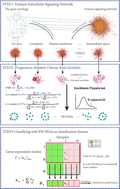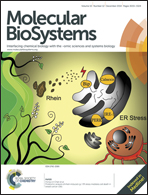Identifying progression related disease risk modules based on the human subcellular signaling networks†
Abstract
Many studies have shown that the structure and dynamics of the human signaling network are disturbed in complex diseases such as coronary artery disease, and gene expression profiles can distinguish variations in diseases since they can accurately reflect the status of cells. Integration of subcellular localization and the human signaling network holds promise for providing insight into human diseases. In this study, we performed a novel algorithm to identify progression-related-disease-risk modules (PRDRMs) among patients of different disease states within eleven subcellular sub-networks from a human signaling network. The functional annotation and literature retrieval showed that the PRDRMs were strongly associated with disease pathogenesis. The results indicated that the PRDRM expression values as classification features had a good classification performance to distinguish patients of different disease states. Our approach compared with the method PageRank had a better classification performance. The identification of the PRDRMs in response to the dynamic gene expression change could facilitate our understanding of the pathological basis of complex diseases. Our strategy could provide new insights into the potential use of prognostic biomarkers and the effective guidance of clinical therapy from the human subcellular signaling network perspective.


 Please wait while we load your content...
Please wait while we load your content...